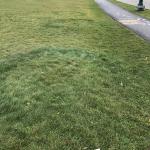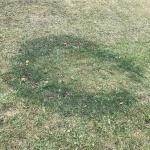When fairy rings occur they typically appear as rings or arcs in lawn turf. Rings can vary in diameter from a few inches to several feet. They often arise in the case of fairly recent lawn construction where organic matter such as tree stumps, large roots, or landscaping debris have been buried, once the turf begins to mature.
Fairy rings normally appear in spring or summer and can be caused by at least 60 different species of fungi. These fungi do not parasitize turf, but instead live on organic matter in the soil. Their activity can alter soil conditions and have a noticeable effect on a lawn. There are three general types of fairy ring:
- Type 1 is characterized by areas of dead turf. These areas are sometimes bordered by turf that is greener than the surrounding turf, and may or may not also contain mushrooms.
- Type 2 contains no dead turf, but consists of a dark green ring of grass that stands out against the surrounding turf. This type also may or may not contain mushrooms.
- Type 3 consists solely of mushrooms, without any noticeable effect on nearby turf.
The fungal mycelium grows as an extensive network underground, and the activities of this network can have different effects on the surrounding turf.
An abundance of mycelium in the soil can make it hydrophobic, meaning that the soil repels water, preventing percolation into the root zone. Because of this condition, the associated turf can begin to suffer from drought stress even when soil moisture is abundant. This phenomenon is sometimes referred to as localized dry spot. The ring itself may be formed by dead or dormant grass, and turf may also die in patches inside or just outside of the ring. The fungal mycelium may also deplete the soil of nutrients, further weakening the turf. Some fairy rings produce hydrogen cyanide, which is toxic to turf.
As they break down organic matter, some fungi release nitrogen into the soil, and turf in or near the edges of these rings may grow more vigorously and have a darker green color as a result. In some cases, excess nitrogen may build up in the soil and lead to ammonium toxicity, which can stunt or kill turfgrass plants.
Other fairy ring fungi go about their business quietly and no symptoms or signs are observed on the lawn until mushrooms appear above the soil surface. Mushrooms are fungal reproductive structures. Copious spores are produced in or on the mushroom and dispersed by wind.
Management of fairy rings can be challenging, but there are several cultural management practices that can be helpful:
- Manage thatch, as turf with an excessive thatch layer (>1”) tends be more susceptible to fairy ring.
- Use careful irrigation to reduce drought stress. Provide areas affected by fairy rings and/or localized dry spots a steady, consistent moisture supply, rather than alternating wet/dry cycles.
- The application of wetting agents may be helpful in promoting the movement of moisture into the root zone.
- Regular aeration can also help to disrupt matted mycelium and promote moisture infiltration.
If necessary, fairy rings can sometimes be masked by fertilizing appropriately and watering deeply, encouraging a more lush growth against which the fairy ring will not stand out. Control weeds that may colonize bare areas. Mushrooms can simply be picked or raked out and removed from the lawn.
Fairy rings tend to be self-limiting and will disappear eventually, although they may sometimes persist for years. Although there are some fungicide products registered for fairy ring management on residential turf, some of the fungi that cause fairy ring are not sensitive to turf fungicides at registered use rates or reside too deeply in the soil for the fungicide to reach. Always follow label instructions and use good cultural management practices to promote overall turf health.
Thorough aeration of affected areas may be combined with a fungicide plus a wetting agent; however, aeration, wetting agents, and irrigation alone may be more effective than fungicide applications. In areas where grass is killed (Type 1 fairy rings), the top 6 inches of sod and soil can be removed and the area re-planted, although this practice is not always effective. Renovation plans that include soil cultivation and mixing have been successful, but these are costly and labor-intensive.
Submitted by: Dr. Angela Madeiras with contributions from Jason Lanier

